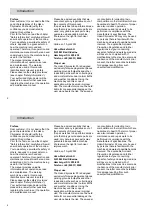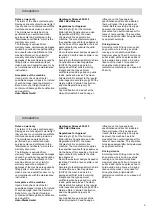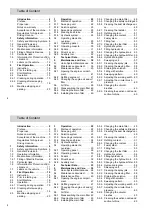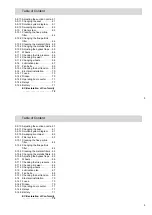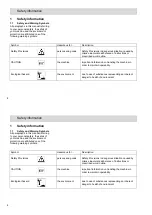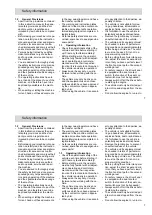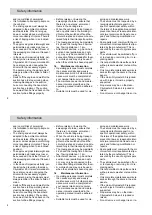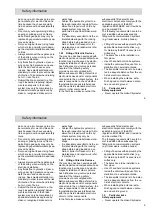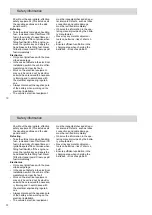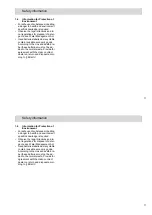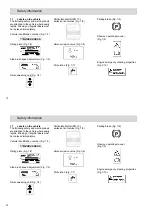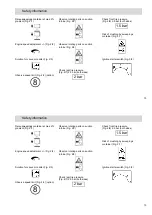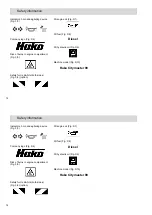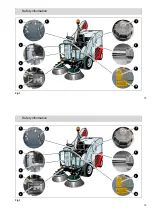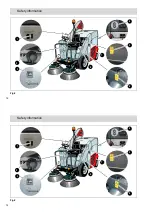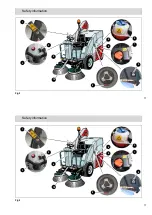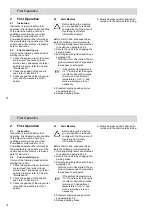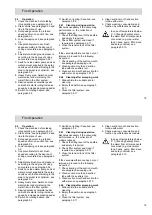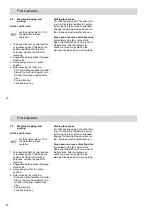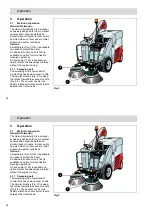
7
Safety information
1.2
General Provisions
• Apart from the provisions contained
in this instruction manual, the gene-
ral safety provisions and the acci-
dent prevention regulations as
imposed by law have to be complied
with.
• Before taking your machine into ope-
ration, carefully read the instruction
manual as well as other separate in-
structions for accessories or atta-
ched implements and comply with all
points mentioned there during work.
• Persons being trained by qualified
Hako technicians only are authori-
sed to operate, service and repair
the machine.
• You are advised to thoroughly study
the safety instructions since precise
knowledge only helps avoiding er-
rors during operation of the machine
and thus guarantee faultless usage
of the machine.
• The operating instructions have to
be at hand at the place of use of the
machine, and therefore have to be
kept readily available at the machi-
ne.
• When selling or letting the machine
for rent, hand out these documents
to the new owner/operator and have
the transfer certified!
• The warning and instruction plates
attached to the machine contain va-
luable advice about safe operation.
Immediately replace incomplete or il-
legible labels.
• As far as safety standards are con-
cerned, spare have to equal genuine
spare parts!
1.3
Operating information
• Check the operational safety of the
vehicle each time before starting it
up! Clear any faults immediately!
• Before starting work, the operator
must be fully familiar with all adjust-
ment, operating and control ele-
ments as well as their respective
function! It is too late to do this when
the vehicle is actually in operation!
• Always wear heavy duty, non-slip
footwear when working with the ve-
hicle.
• The vehicle may only be driven on
and the equipment used on those
surfaces which have been approved
by the contractor or person appoin-
ted by him.
• When using the vehicle, it is essenti-
al to pay attention to third parties, es-
pecially children.
• The vehicle is not suitable for clea-
ring up hazardous, inflammable or
explosive fluids, dust or substances.
• It is forbidden to use the vehicle in
potentially explosive atmospheres.
• Remove the ignition key to prevent
unauthorized use of the vehicle.
• The vehicle and its equipment must
be checked in terms of perfect wor-
king condition and operational safety
before being put into use. The vehic-
le must not be used if it is not in a
proper working condition.
• Before putting the vehicle into opera-
tion, adjust the driver's seat and mir-
ror so that you have a perfect view of
the front and rear path of travel and
working area!
• For safety reasons, the driver's seat
is equipped with a seat contact
switch; the function of the seat con-
tact switch must not be bypassed!
• Always switch off all the drives befo-
re starting the engine.
• The vehicle must only be started, put
into motion and stopped from the se-
at.
• Do not allow the engine to run in clo-
7
Safety information
1.2
General Provisions
• Apart from the provisions contained
in this instruction manual, the gene-
ral safety provisions and the acci-
dent prevention regulations as
imposed by law have to be complied
with.
• Before taking your machine into ope-
ration, carefully read the instruction
manual as well as other separate in-
structions for accessories or atta-
ched implements and comply with all
points mentioned there during work.
• Persons being trained by qualified
Hako technicians only are authori-
sed to operate, service and repair
the machine.
• You are advised to thoroughly study
the safety instructions since precise
knowledge only helps avoiding er-
rors during operation of the machine
and thus guarantee faultless usage
of the machine.
• The operating instructions have to
be at hand at the place of use of the
machine, and therefore have to be
kept readily available at the machi-
ne.
• When selling or letting the machine
for rent, hand out these documents
to the new owner/operator and have
the transfer certified!
• The warning and instruction plates
attached to the machine contain va-
luable advice about safe operation.
Immediately replace incomplete or il-
legible labels.
• As far as safety standards are con-
cerned, spare have to equal genuine
spare parts!
1.3
Operating information
• Check the operational safety of the
vehicle each time before starting it
up! Clear any faults immediately!
• Before starting work, the operator
must be fully familiar with all adjust-
ment, operating and control ele-
ments as well as their respective
function! It is too late to do this when
the vehicle is actually in operation!
• Always wear heavy duty, non-slip
footwear when working with the ve-
hicle.
• The vehicle may only be driven on
and the equipment used on those
surfaces which have been approved
by the contractor or person appoin-
ted by him.
• When using the vehicle, it is essenti-
al to pay attention to third parties, es-
pecially children.
• The vehicle is not suitable for clea-
ring up hazardous, inflammable or
explosive fluids, dust or substances.
• It is forbidden to use the vehicle in
potentially explosive atmospheres.
• Remove the ignition key to prevent
unauthorized use of the vehicle.
• The vehicle and its equipment must
be checked in terms of perfect wor-
king condition and operational safety
before being put into use. The vehic-
le must not be used if it is not in a
proper working condition.
• Before putting the vehicle into opera-
tion, adjust the driver's seat and mir-
ror so that you have a perfect view of
the front and rear path of travel and
working area!
• For safety reasons, the driver's seat
is equipped with a seat contact
switch; the function of the seat con-
tact switch must not be bypassed!
• Always switch off all the drives befo-
re starting the engine.
• The vehicle must only be started, put
into motion and stopped from the se-
at.
• Do not allow the engine to run in clo-


